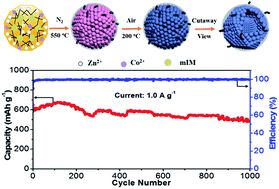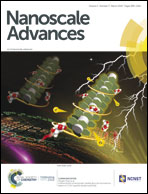In situ formation and superior lithium storage properties of tentacle-like ZnO@NC@CNTs composites†
Abstract
As a typical conversion-type electrode, ZnO has high theoretical Li+ storage capacity and is low cost. However, its practical application is far away due to its limited rate performance and cycle stability. Herein, a novel structure of double carbon coated tentacle-like ZnO composite has been synthesized, which features in situ grown carbon nanotubes (CNTs) embedded in yolk–shell polyhedra, consisting of nitrogen-doped carbon layer (NC) coated ZnO nanoparticles (ZnO@NC@CNTs). Excellent rate performance and good cycling stability are observed in the obtained ZnO@NC@CNTs, including a high reversible capacity of 800 and 617 mA h g−1 at 0.1 and 1.0 A g−1 and a low capacity decay of only 0.019% per cycle during 1000 cycles at 1.0 A g−1. The unique structure of this double carbon NC@CNTs host can not only enhance electron transport throughout the whole electrode but also well accommodate the volume changes of ZnO during cycling, resulting in improved rate capability and cycle stability. In addition, the porous yolk–shell structure of the ZnO@NC@CNTs composite provides better contact between the electrolyte and active material, which enhances both capacity and rate performance of the electrode.



 Please wait while we load your content...
Please wait while we load your content...